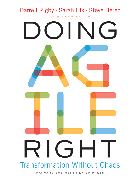What matters most in an Agile organizational structure
Forcing an Agile approach onto team members causes more problems than it solves. 'Doing Agile Right' distills real-world experience into advice -- including when to delay change.
Agile enables software innovation, but it takes some legwork to get to there. There's no shortcut to an Agile organization reaping the benefits of customer connection and iterative development flows.
Organizations can take many routes to Agile adoption. They can place more emphasis on UX or invest in tools that enable faster product releases. These measures help, but innovation will stagnate without an Agile organizational structure to encourage and support the methodology.
Organizational changes are where many companies -- enterprises in particular -- struggle. Tooling can change, but it's difficult to manage, encourage and scale Agile as a strategy across the business. People get mired in misconceptions and misguided attempts to change, which only exacerbates the problem.
Doing Agile Right: Transformation Without Chaos, by Darrell K. Rigby, Sarah Elk and Steve Berez, Bain & Company consulting experts, delves into various Agile adoption challenges. The authors rely on their consulting experience with companies looking to release products more quickly and embrace innovation.
Agile concepts and tenets challenge the status quo for many organizations. But comprehending Agile is just the first step -- then you have to make the methodology work across teams with disparate functions and goals.
Chapter 6 of the book, Agile Organization, Structures, and People Management, gets into the personnel minutiae. Reorganization is a tempting maneuver for company leadership, but it's not one to take lightly, the writers warn. "This chapter discusses our recommendations, such as why we seldom begin with restructurings and why tuning the talent engine is a critical and often underestimated lever in the transition."
Business leaders should prioritize the organization's operating model over its formal structure, they advise. The formal structure is simply an employee reporting structure, while the operating model digs into management systems, leadership, culture, budgeting and individual accountability. Every organization should put thought into its operating model, and then strategize accordingly -- even if it leaves some question marks for later:
No structure will ever be perfect. The good news is that it doesn't need to be. By intelligently mixing all the elements of the operating model, executives can ensure that no single element constrains success. A structure change may not be needed -- or else it can be significantly delayed in order to focus on changes in areas such as decision rights, leadership, and ways of working.
Put down the cookie cutter
An Agile organizational strategy that works for one organization won't necessarily work for another. The chapter excerpt includes a Spotify org chart, which the authors describe as, "Probably the most frequently emulated agile organizational model of all." But an Agile model that serves as a standard of success won't necessarily replicate to another organization well.
Agile software developers aim to better meet customer needs. To do so, they need to prioritize, release and adapt software products more easily.
Unlike the Spotify-inspired tribe structure, Agile teams should remain located closely to the operations teams that will ultimately support and scale their work, according to the authors. This model, they argue in Doing Agile Right, promotes accountability for change, and willingness to innovate on the business side.
Any Agile initiative should follow the sequence of "test, learn, and scale." People at the top levels must accept new ideas, which will drive others to accept them as well. Then, innovation comes from the opposite direction. "Agile works best when decisions are pushed down the organization as far as possible, so long as people have appropriate guidelines and expectations about when to escalate a decision to a higher level."
A successful Agile transformation might require some pilot teams and perhaps several years to scale across the business, as was the case with Bosch Power Tools, profiled as an example in Doing Agile Right. In this excerpt, learn from Bosch's example of Agile adoption, and how one of its business units used Lego blocks to visualize its Agile organizational structure.
Editor's note: This excerpt is from Doing Agile Right: Transformation Without Chaos, authored by Darrell K. Rigby, Sarah Elk and Steve Berez, published by Harvard Business Review Press, May 25, 2020, ISBN: 9781633698703.







